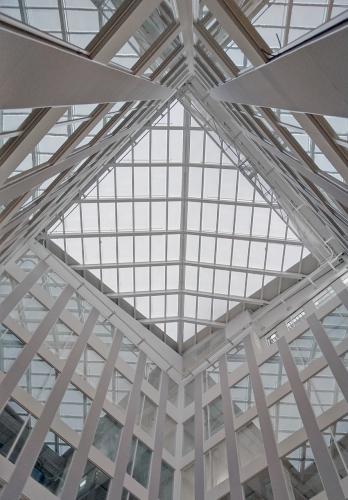The heating and cooling of Trimble’s new Finland offices and the entire district around them are produced by using Fortum’s custom-made comprehensive and energy-efficient solution. For the first time for Fortum, the system running with zero-emission electricity will use industrial-scale air-water heat pumps. Trimble NIS was an essential tool for Fortum in this project, too.
A regional energy ecosystem was custom-designed to match the needs of the developer and users of the new Oasis of Professionals (OOPS) business campus in the Leppävaara district of Espoo, Finland. Why did Finland’s state-owned energy company Fortum choose this solution, what is the system based, on and how does it work in practice?
“This is a project of several years that kicked off when construction company NCC started development in the Hatsinanpuisto area of Espoo,” recalls sales manager Tuomas Hytönen of Fortum’s heating and cooling unit. ”NCC was looking for an energy-provider to partner with, and we were willing to develop a comprehensive solution because of our existing heat plant in the area. By utilizing the existing plant, we were able to effectively and in a centralized manner bring both heating and cooling on the plot.”
“We chose a new type of solution. A traditional model was never on the drawing board as there was a need to use a specific hybrid of heating and cooling. For the first time in Fortum’s history, the new solution uses an industrial-scale air-water heat pump- and water circulation-based system that can produce both heating and cooling. In the same connection, Fortum founded a low-temperature network that can produce heat using less power and a lower temperature. Heat is produced with electricity that does not emit any CO2”, Hytönen says.
Fortum’s plant caters to the entire Hatsinanpuisto area covering approximately 80,000 m2, and if necessary, the plant has capacity to provide for the nearby districts of Perkkaa and Vermo, too. The company’s district heating network extends to more than 870 km in Espoo, Kauniainen and Kirkkonummi and provides for more than 200,000 households. The entire district heating and cooling network is managed in Trimble's Network Information System (NIS).
The system is used daily at Fortum’s sales, construction management, network maintenance and engineering departments – and in this project, too. All network-related information is documented in the system, for both new project planning and the maintenance of existing networks. The software is used by dozens of employees at Fortum. Moreover, the system plays an important role in enabling new more sustainable solutions.
Trimble and Fortum are business partners with shared objectives that include new technology and sustainable solutions.
“There are several important factors driving this project,” says Hytönen. “At Fortum, we want to use new technology that has been applied to residential projects but not to cover a larger area like this. We wanted to make sure that this solution, which looks very ecological on the drawing board, will work in practice, too. This area was optional for the application because we have our own district heat plant nearby as back-up support. The offices on the OOPS campus will not get cold despite a break in the pump system,” Hytönen says.

“Ecology and local production are important values to us, because like other major energy companies, we aim at completely carbon-free production. Our objective is to achieve this by 2025 i.e. 10 years before the national target in Finland. This is when our very last coal-fired power plant is to shut down in Suomenoja, Espoo. Its production will be replaced by plants using renewable sources of energy and bioenergy which Fortum has in Kivenlahti, Espoo, for example. During the lowest temperatures in the winter we ensure extra heat with natural gas. In addition, we recover waste heat from different industries and data centers, and in the future geothermal energy. All in all the idea is to move towards a distributed production system i.e. to increase the use of local units and forms of energy. The solution in Hatsinanpuisto supports this overall strategy while meeting the needs of the client and the sustainability objectives of both Trimble and Fortum,” Hytönen says.
Fortum’s existing heat plant can be operated parallel and in exchange with the new plant that joins the existing network.
“Hatsinanpuisto has its own network, but the heat plant is connected to a larger network to secure consistent production,” Hytönen explains. “The cooling network for the area is extending, too, and will be offered for the new properties to be built in the district of Vermo. Consequently, the system has further potential to serve the habitants of the nearby areas and North Leppävaara at large. The capacity for the area north of the railroad has not been surveyed yet.”
“Our value proposition is a supply-secure and carefree energy solution where local energy production is backed up by traditional district heating. Thus ensure sustainable production and distribution. Our solution is delivered based on the thermal power requirements by the building engineers until the mechanical room of the property, and along the way since early project planning we are in active dialogue with the building designers to determine the power requirements and piping connections – with the help of Trimble NIS.”

